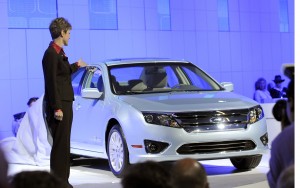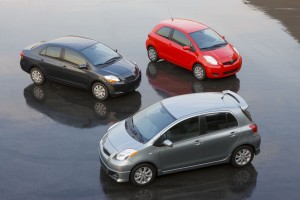
The Ford Fusion (the hybrid version shown here) had the highest loyalty of any model in the U.S. market during the first quarter.
While the U.S. car market has “clearly turned the corner” from last year’s decades-low slump, this year’s slow turnaround is treating some makers better than others – and threatens the very survival of some marques.
Domestic makers are, on the whole, gaining ground according to an analysis of first-quarter 2010 new vehicle registration data, though the clear winner is Ford Motor Co. For imports, the situation is more mixed. Honda and Nissan were able to make some gains, reports research firm Experian Automotive, but the ongoing series of safety recalls and quality glitches clearly took a toll on the industry giant, Toyota.
“Toyota was the only major manufacturer (other than Chrysler) not up by double digits” during the first three months of 2010, noted Jeffrey Anderson, Experian’s Director of Consulting & Analytics.
Significantly, the damage to Toyota’s image is having an impact in the market, especially among those motorists who the company has long counted on to keep building its sales and market share. According to Anderson, the Japanese maker appears to be having far more trouble “conquesting.”
“Toyota traditionally had a large chunk of its sales come from domestic buyers who never owned an import,” Anderson added, but the number of buyers “conquested” from Detroit’s Big Three brands fell by nearly half during the quarter. That alone “probably cost” the carmaker 37,000 lost sales during the first quarter, or about 15% of its total volume.
In turn, that helped drive down the embattled automaker’s share from 16.2% last year to 15.6% during the January-March period. A year ago, Toyota had passed Ford to become the second-largest brand in the U.S. market, and as GM sank into bankruptcy it seemed poised to grab the top spot. (As it did on a global scale, in 2008.) But now, Toyota has slipped into third and industry analysts are questioning the automaker’s ability to rebuild its momentum anytime soon.
Notably, Toyota had no products among the top five growth models during the quarter, though its Yaris subcompact posted one of the sharpest declines of any model in the market – even though sales of small cars have continued to grow.
Chrysler and Kia also had some of the biggest losers, by nameplate. But the Korean carmaker’s sibling brand, Hyundai, fielded the second-biggest growth model, the new Sonata sedan.
Significantly three of the top five “gainers,” according to Experian, came from Ford: the F-150 pickup, Fusion sedan and Escape SUV. Overall, Ford and Nissan showed the biggest sales gains of all brands during the first quarter.
Ford also showed gains in terms of improving customer loyalty – always a challenge for a brand. According to Anderson, the Detroit maker had a repeat sales rate of 49%, a full point better than Toyota. And among individual models, the Ford Fusion was tops, with a nearly two-thirds repeat sales rate.
While Toyota may be having a tough time, it still managed to gain sales from Detroit in the first quarter, just not as aggressively as before and, significantly, it began to bleed buyers to Honda, which also posted some measurable gains during the three-month period.
But some of the biggest setbacks were dealt to small makers, like Chrysler, which is still struggling to reverse its steady decline, and especially to the weakest of the Japanese brands. Suzuki saw its sales for the first quarter drop by roughly two-thirds, further underscoring the concerns industry analysts have raised about the Japanese brand’s ability to keep operating in the American market.
In terms of models segments, full-size pickups still dominated the market, and actually showed some renewed life during the first quarter. But the real momentum belongs to crossovers, which have surged from 15% to 20% of the new vehicle market over the last two years, noted Anderson.
Looking at one of the segment’s big losers, Anderson suggested that the minivan market seems to be stabilizing at about 5%, or a projected 500,000 for all of 2010. “Is it dead? No, it’s still a viable segment,” he concluded.


Not only Suzuki, but Mitsubishi and Smart belong on a death watch also.